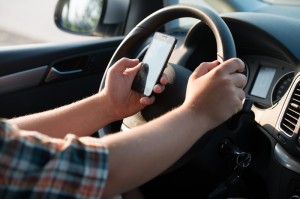Are the Uber, Lyft and other ride-sharing drivers using those apps working against efforts to limit distracted driving in Michigan?
Drive down the streets of Lansing, Grand Rapids, or Kalamazoo these days and you’ll see something that might frighten you. Just the other day, one of our car accident attorneys  came to a red light and pulled alongside another car with a sign saying it was ready for hire through Uber. As we have previously posted, UberX is the ride-sharing service that is turning everyday Michiganders into unofficial taxi cab drivers. But what was most disturbing was not the advertisement plastered outside the vehicle, but what was inside of it. The Uber driver had two or three smartphones mounted to the windshield, all of them simultaneously using the Uber or Lyft apps, presumably to solicit new riders. In the era of awareness of distracted driving, one has to ask: is this safe? Is it safe for someone to be driving a car with using multiple cell phones to connect with other people to arrange a ride? More importantly, our car accident attorney wondered: does Uber’s technology promote distracted driving?
came to a red light and pulled alongside another car with a sign saying it was ready for hire through Uber. As we have previously posted, UberX is the ride-sharing service that is turning everyday Michiganders into unofficial taxi cab drivers. But what was most disturbing was not the advertisement plastered outside the vehicle, but what was inside of it. The Uber driver had two or three smartphones mounted to the windshield, all of them simultaneously using the Uber or Lyft apps, presumably to solicit new riders. In the era of awareness of distracted driving, one has to ask: is this safe? Is it safe for someone to be driving a car with using multiple cell phones to connect with other people to arrange a ride? More importantly, our car accident attorney wondered: does Uber’s technology promote distracted driving?
Michigan (as well as other states) has gone to great lengths to limit distracting driving. In addition to the numerous campaigns that spell out in no uncertain terms the consequences that can arise from distracted driving, there are statutes that also attempt to limit its occurrence. For instance, MCL 257.602b provides in part,
[A] person shall not read, manually type, or send a text message on a wireless 2-way communication device that is located in the person’s hand or in the person’s lap, including a wireless telephone used in cellular telephone service or personal communication service, while operating a motor vehicle that is moving on a highway or street in this state.
Further, Michigan law, specifically that statue, goes on to limit phone use, whether for texting or making or receiving phone calls, for those driving certain types of vehicles, except in case of emergency and other reasons explicitly enumerated in the statute.
Ride-share services like Uber require that their drivers use smartphones constantly. It’s just how the technology works. There is no central dispatch that sends drivers to pick up riders. Rather, drivers and riders connect using Uber’s app to arrange trips and negotiate a price. Doesn’t the use of this kind of technology violate the language, or at least the spirit, of Michigan’s distracted driving laws? An argument could indeed be made that the very nature of the Uber technology (as well as those used by other ride-sharing enterprises) work against the very spirit of the continuous campaign to limit distracted driving not only in Michigan but across the country.
All of us should are interested in technological innovations. All of us love the convenience of our smartphones. But all of us should be rightfully concerned about smartphone technology jeopardizing safety on Michigan roads. Michigan has a distracted driving law because we know that using a cell phone in a car is dangerous and causes serious accidents that result in injury or death. So, are we really ready to have people driving around Lansing or Grand Rapids juggling multiple cell phones trying to arrange their next Uber trip? Is that safe for our communities?
